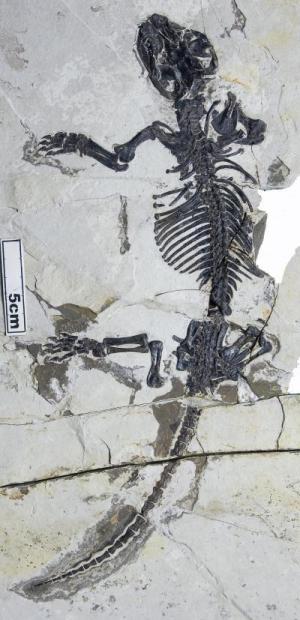Please note: Osher Rainforest will be closed for maintenance Jan. 14–16.
Science News
The Middle Ear
April 19, 2011

Yesterday it was eyes, today, ears. Here’s a tease from the New York Times:
So reptiles eat with the bones we hear with.
Sounds like a casual conversation, right? It kind of is, among scientists. They have known this for years—that reptiles eat with the same bones we mammals have in our ears—but have had a hard time tracing back its roots. Until now.
Paleontologists from the American Museum of Natural History (AMNH) and the Chinese Academy of Sciences have discovered Liaoconodon hui, a complete fossil mammal from the Mesozoic, found in China that includes the long-sought transitional middle ear. Their discovery is published in Nature.
The transition from reptiles to mammals has long been an open question, although studies of developing embryos have linked reptilian bones of the lower jaw joint to mammalian middle ear bones. The mammalian middle ear—the area just inside the eardrum—is ringed in shape and includes three bones, the malleus, incus and ectotympanic, two of which are found in the joint of the lower jaw of living reptiles.
The fossil of Liaoconodon hui is particularly complete, and its skull was prepared from both dorsal and ventral sides, allowing Jin Meng, curator in the Division of Paleontology at AMNH, and his colleagues to see that the incus and malleus have detached from the lower jaw to form part of the middle ear. These bones remain linked to the jaw by the ossified Meckel's cartilage that rests in the groove on the lower jaw. The team hypothesizes that in this early mammal, the eardrum was stabilized with the ossified cartilage as a supporting structure.
“People have been looking for this specimen for over 150 years since noticing a puzzling groove on the lower jaw of some early mammals,” says Meng, lead author of the paper. “Now we have cartilage with ear bones attached, the first clear paleontological evidence showing relationships between the lower jaw and middle ear.”
Some people dream of winning the lottery, but not this paleontologist. “I've always dreamed of a fossil with a good ear ossicle,” says Meng. “Now, we have had this once in a lifetime discovery.”
Image credit: Meng, et al 2011 ( Nature)